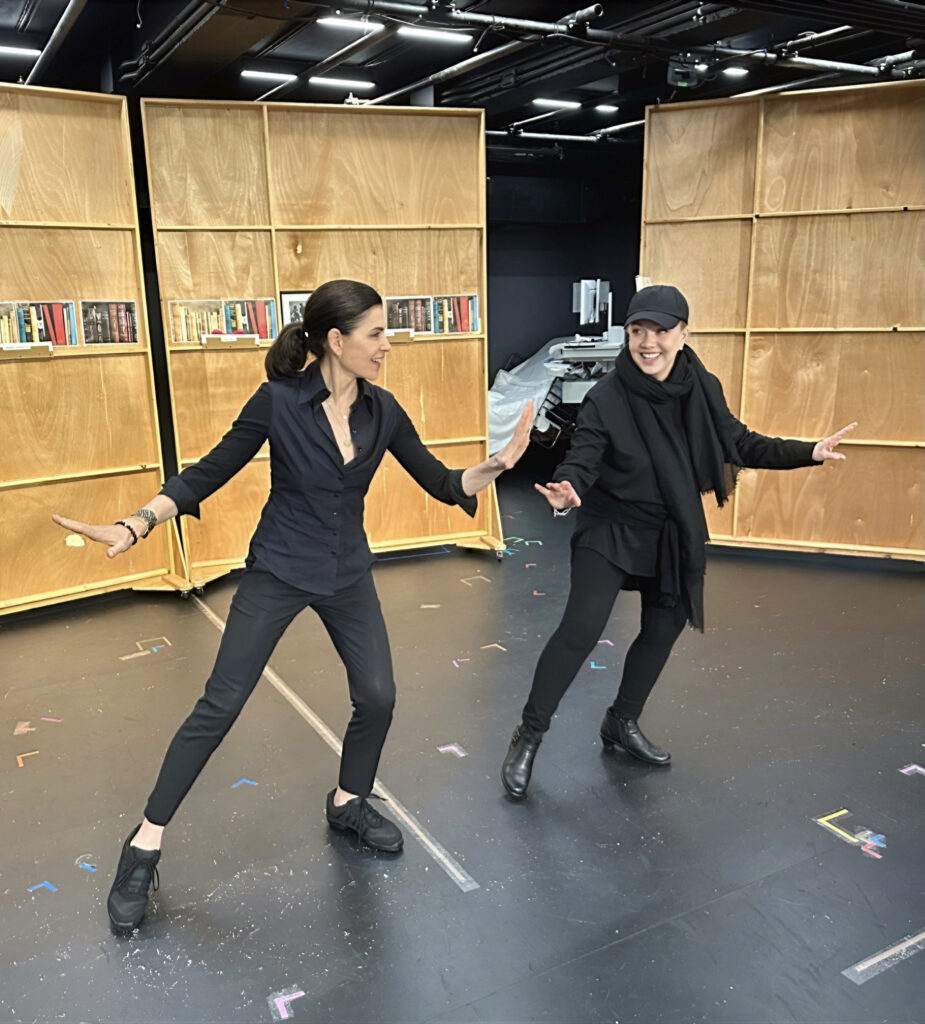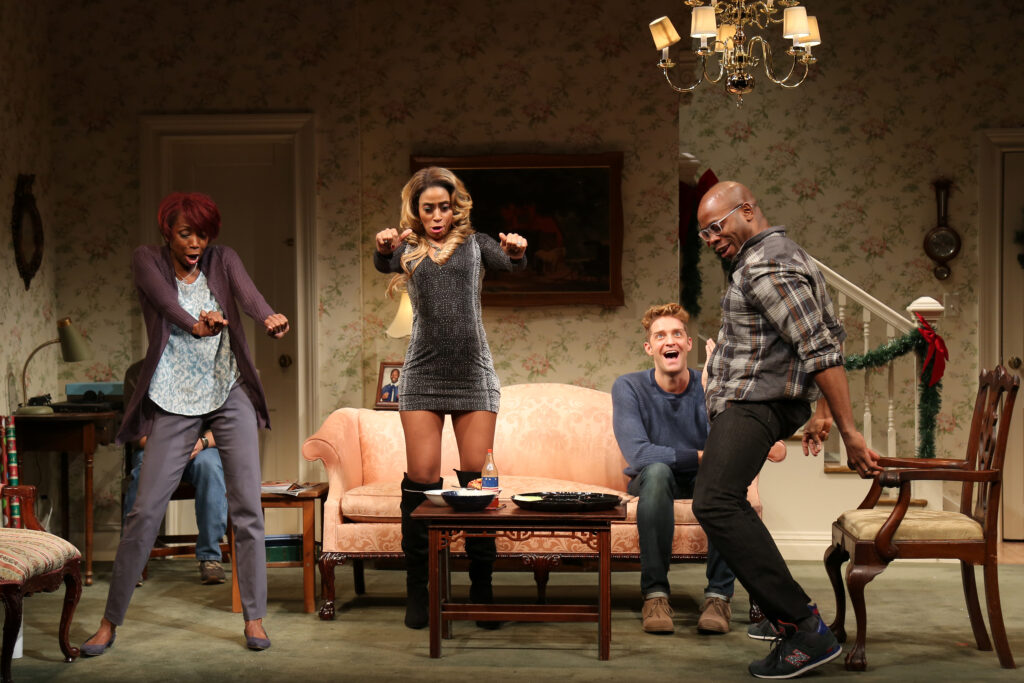“It’s about the storytelling,” says Susan Stroman.
“It’s about when the audience walks in, what are they gonna see?” says Sonya Tayeh.

“It’s such a weird, such a specific thing in the industry,” says Sam Pinkleton.
The “it” is choreographing plays—which can mean adding subtle movement that never registers as choreography, or creating an unapologetic, front-facing dance number, or designing dancing that looks totally spontaneous—mostly without any dance-trained bodies.
The tasks vary with each play. This month, Tayeh’s work is animating Romeo + Juliet, Sam Gold’s music-driven, Gen Z reimagining of Shakespeare, with Kit Connor and Rachel Zegler in the title roles at the Circle in the Square Theatre. Over at the James Earl Jones, Stroman has directed Delia Ephron’s stage version of her bittersweet memoir, Left on Tenth, starring Julianna Margulies as the widowed writer embarking on a late-life romance with a former beau, played by Peter Gallagher. And Pinkleton’s madcap direction of Cole Escola’s farcical hit Oh, Mary! is garnering guffaws in the show’s repeatedly extended run at the Lyceum Theatre.
 Pinkleton (in hat) at a rehearsal for Oh, Mary! Photo by Rebecca J Michelson, Courtesy Grapevine Public Relations.
Pinkleton (in hat) at a rehearsal for Oh, Mary! Photo by Rebecca J Michelson, Courtesy Grapevine Public Relations.
Pinkleton, Tayeh, and Stroman were willing to turn away from their latest projects—Pinkleton had moved on to a “participatory dance musical” in Scotland—and share thoughts about working on plays with a reporter because, well, it’s just so interesting. “Every show has its own set of rules,” says Pinkleton. “Our job as creators is to really listen to what the thing is and what the thing needs.”
And, it can just be fun. “Let’s face it: On a musical the choreographer is carrying the whole building on their back, it’s such a massive job,” he says. “But on a play, there’s a way that a choreographer can look at a thing with a razor-sharp focus and be like, ‘Oh, this is how we can explode the truth of this one moment.’ ”
Tayeh’s enthusiasm for her Shakespeare assignment spills out in a rush of questions: “What does falling in love at these kids’ age mean? What does it mean to go to a party with your family’s enemy? What does the balcony scene look like? How does Romeo get up there? And the innocence in Juliet—what does that look like? Their first palm-to-palm, their first kiss? It’s so juicy, right?”
“Let’s Run Around”
Tayeh sees potential for movement in all of Romeo + Juliet, not just in the play’s ballroom scene and street brawls. “Every breath is a dance, every step matters,” she says. And Gold’s decision to lean into the youth of the protagonists allows Tayeh to embrace the spacious set (by the design collective known as dots) and the theater’s arena-style architecture. “When are teenagers linear?” she asks. “When are they frontal and steady? So let’s run around and fight and yell and roll around and dance and try to release and explore. These are pent-up kids that have been taught about and have seen violence at a really young age.” Movement, she says, “doesn’t mean, ‘Okay, this is the part where they dance.’ ”
Stroman’s characters in Left on Tenth—the title refers to a 10th Street address in Manhattan’s Greenwich Village—are at the other end of the life cycle. Ephron’s book starts when she’s in her 70s, on the verge of losing the love of her life to cancer, and it morphs into a rom-com about her late-life love affair. Having Margulies and Gallagher yell and roll around isn’t an option. But Stroman explains that even when directing a play, she uses her dancer’s understanding of timing and rhythm, applying it as much to dialogue as to staging. She adds that landing the jokes in POTUS: Or, Behind Every Great Dumbass Are Seven Women Trying to Keep Him Alive, the political satire she directed in 2022, required some split-second moves.
With Left on Tenth, Stroman is sneaking in some dance, because Ephron and her husband had enjoyed taking tap classes together. So Margulies has taken some lessons too, and will be executing Stroman’s choreography. “Simple,” Stroman promises, “nothing intricate”—as befits the character and the context. “The show is about seizing life—the highs and lows,” she notes. “Part of that is doing something outside your comfort zone, and in this memoir, it was tap dancing.”
 From left: Julianna Margulies and Susan Stroman rehearsing Left on Tenth. Photo by Scott Bishop, Courtesy Stroman.
From left: Julianna Margulies and Susan Stroman rehearsing Left on Tenth. Photo by Scott Bishop, Courtesy Stroman.
There was no tapping when Stroman directed her first play, Dot, by Colman Domingo, in 2016, but there was a scene in which the family matriarch, who has Alzheimer’s, mistakes her son for his father and asks him to dance with her. Stroman’s ballroom steps provided “a poignant, heartbreaking moment,” she says. But with or without actual choreography, her approach remains the same: “I zoom in on the character,” she says, “and try to make the character three-dimensional. I want to make sure I’m delivering a story to that audience, whether through dance or through directing a scene.”
 The cast of the play Dot, directed by Stroman. Photo by Carol Rosegg, Courtesy Stroman.
The cast of the play Dot, directed by Stroman. Photo by Carol Rosegg, Courtesy Stroman.
Zooming in on characters means working with actors, not all of whom have the physical gifts that choreographers are accustomed to. Stroman says that in both plays and musicals, “one has to respect the abilities of the actors—whether they are quick studies or take a very long time to learn, whether they are nimble on their feet or have trouble moving. You have to recognize that early on in the rehearsal process and use it.”
“This Is How You Plié”
Stroman adds that even non-nimble types can benefit from working with a choreographer. “You can help any actor feel good about his body,” she says, “about what he has to do onstage. It might be flipping over a sofa or balancing on a table. A choreographer might say, ‘This is how you fall off of this table’ or ‘This is how you plié in order to get up on this chair.’ Even though a choreographer’s not doing dance steps, they’re so aware of their body that they can infuse an actor with that information, even through the most serious scene.”
They can also draw out information an actor already has, Pinkleton says. “Sometimes people need a choreographer to stand there and say, ‘Oh, do that again’ or ‘Do that bigger’—just to help them towards their own intuition,” he notes. “A huge part of our job is just getting people to trust that the thing they want to do is the thing to do.”
Oh, Mary! is only 80 minutes long, but its rambunctious physical comedy, Pinkleton says, “is like doing the Olympics” for the actors. They’re not dancers, but he started every rehearsal with a “full-on” warm-up, and found they could be “like athletes, flinging their bodies around.”
His admiration extends to other actors he’s encountered over the years, on plays ranging from Macbeth (with Daniel Craig and Ruth Negga) to the 1920s Expressionist classic Machinal. “Some of my absolute favorite collaborators,” he says, “are actors who never in a million years would identify as dancers. I love anyone who’s game. I’ve worked with people who have a lot of physical or dance experience, but are terrified. I would take no experience but open-minded and game over lots of experience but terrified and closed-off any day of the week.”
The youthful Romeo + Juliet cast would be right up his alley, from what Tayeh says. She describes the cast as “beautiful movers,” but also as “an open group, with a soulful, heartfelt curiosity” that inspires her: The moves onstage “come from these kids, from hormones, from heat.”
 Sonya Tayeh (center) at a rehearsal for Romeo + Juliet. Photo by Emilio Madrid, Courtesy Polk & Co.
Sonya Tayeh (center) at a rehearsal for Romeo + Juliet. Photo by Emilio Madrid, Courtesy Polk & Co.
Opening Another Dimension
Pinkleton calls the work he did on Macbeth “invisible,” but he clearly doesn’t mind. “I was moving a company of 16 actors around a big, empty stage in relation to each other,” he says. “And I was also warming them up. I was making a company from a physical place—which was totally joyous.”
What he, Stroman, and Tayeh inject into the plays they do isn’t necessarily “capital-D dance,” as Pinkleton puts it. But it’s not actually invisible, either. He recalls a job—short-term contract, one afternoon, one actor—working on a “tiny bit of movement” that “unlocked another level for the play. It just opened up another dimension.”
Stroman sees that too. “Our movement strengthens a character’s emotions and strengthens a character’s identity,” she says. “It’s very important.” And Tayeh concurs. “Even when it’s ‘We just need you for this one moment,’ I put everything in that moment—so it feels like not just that moment. And if it connects to you, if you felt something, that means we did our job.”




GIPHY App Key not set. Please check settings